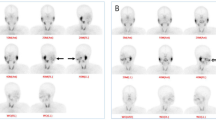Abstract
Pneumonia is the feared consequence of persistent aspiration of saliva. Although some persons with impaired protection of the laryngeal airway are thought to be at risk, it is not known with certainty which factors are important. Some patients receive tracheostomies to enhance airway safety, often without clear evidence of aspiration of oropharyngeal secretions. A simple, readily available technique is described by which oral secretions are scintigraphically labeled with technetium-99m sulfur colloid via slow intraoral infusion. Subsequent sequential chest imaging with a gamma camera allows detection and tracking of the aspirated material. Three persons are described in whom this technique was used. Inone, the scintigraphic analysis was instrumental in implicating infected saliva as the likely source of recurrent pulmonary infections. Although the method is useful in detecting aspiration of saliva in high risk persons, more study is needed to equate the degree of aspiration visualized with the risk of pulmonary disease.
Similar content being viewed by others
References
Johansen W, Pierce A, Sandord J: Changing bacterial flora of hospitalized patients; emergence of gram-negative bacilli.N Engl J Med 281:1137–1140, 1969
Cameron J, Zuidema G: Aspiration pneumonia—magnitude and frequency of the problem.JAMA 219:1194–1196, 1972
Gilbert R, McIlwain J, Brynce D, Ross I: Management of patients with long-term tracheostomics and aspiration.Ann Otol Rhinol Laryngol 96:561–564, 1987
Lindeman R, Yarrington C, Sutton D: Clinical experience with the tracheoesophageal anastomosis for intractable aspiration.Ann Otol 85:609–612, 1976
Amberson J: A clinical consideration of abscesses and cavities of the lung.Bull Johns Hopkins Hosp 94:227–237, 1954
Winfield J, Sande M, Gwaltney M: Aspiration during sleep.JAMA 223:1288, 1973
Huxley E, Viroslav J, Gray W, Pierce A: Pharyngeal aspiration in normal adults and patients with depressed consciousness.Am J Med 64:564–568, 1978
Bartlett J, Gorbach S, Finegold S: The bacteriology of aspiration pneumonia.Am J Med 56:202–207, 1974
Johansen W, Harris G: Aspiration pneumonia; anaerobic infections and lung abscess.Med Clin North Am 64:385–395, 1980
Cameron J, Caldin P, Toung J, Zuidema G: Aspiration pneumonia: physiologic data following experimental aspiration.Surgery 72:238–245, 1972
Author information
Authors and Affiliations
Rights and permissions
About this article
Cite this article
Silver, K.H., Van Nostrand, D. Scintigraphic detection of salivary aspiration: Description of a new diagnostic technique and case reports. Dysphagia 7, 45–49 (1992). https://doi.org/10.1007/BF02493421
Issue Date:
DOI: https://doi.org/10.1007/BF02493421




